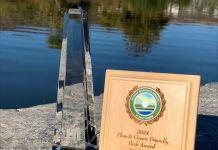A group of 15 volunteers removed 4,200 pounds of trash from a Santee River Park clean up held April 21 in honor of Earth Day.
San Diego River Park Foundation Chief Associate Director Sarah Hutmacher said the foundation typically has to remove between 50,000 to 100,000 pounds of trash each year from the area where Forester Creek meets Carlton Oaks Golf Course.
It is important, she said, to understand that the site connects all of El Cajon to the San Diego River; that one junction connects almost 20% of the local watershed with the Pacific ocean so it is a critical part of San Diego’s water system. Sadly, she said, it also gathers a huge amount of trash in the process.
“We get all sorts of stormwater debris; there is a section that goes past Gillespie Field where there’s a concrete channel and then right as it goes into Santee it is vegetated with an earthen bottom.
Unfortunately, that means it gets all hung up with garbage. There’s tons and tons of small things- it’s a trash ‘hotspot’,” Hutmacher said.
In addition to holding regular clean-up events, River Park Foundation employees consistently examine collected trash to make connections and determine the root cause. Often, she said, information lies in homeless encampments.
“Our staff is primarily ecologists but we analyze the trash and it helps to target the intersection of social services and the environment— we end up targeting homeless encampments. We’ve gotten to know some of the people living in the river bed, developed some trust and seen some of their hardships. It’s pretty motivating to see how we can solve some social issues,” Hutmacher said.
Frequenting areas where trash builds up, whether or not it has any connection to homeless encampments also gives staff a sense of how to organize volunteer events.
“We have a small trained team, even during COVID, who collect data about trash quantity, trash type, access notes so we make sure we send the right resources. You know, do we need lots of shovels or a grappling hook for a large, bulky item? Is there hazardous material involved? Is it tricky to access? Collecting that data is really important,” Hutmacher said.
Figuring out what they are dealing with dictates who they will contact for volunteer efforts, she said, whether it is a young troop of Girl Scouts for small pieces of garbage or a volunteer Navy group for heavy lifting.
Collecting data ahead of time and understanding what different sites need is a really important factor in planning for regular clean-ups, Hutmacher said.
For example, the national One Tree Planted group who helped at this recent clean-up focuses on trash removal in this area, but might focus on reforestation efforts elsewhere in the nation. On the other hand, volunteers from locally-based Ponto shoes who promote ocean conservation are a natural fit for this particular clean-up where trash was being removed before it could end up in the Pacific ocean. The site itself dictates what maintenance is required, but also what volunteer groups might be best suited for those efforts.
Although COVID has limited their ability to organize large events, Hutmacher said the team is beginning to get a sense of how protocols will work as things open back up.
“Many hands make light work and this recent event was one where we could bring a small number of volunteers together in a safe but effective manner. It was really encouraging for us,” Hutmacher said.













